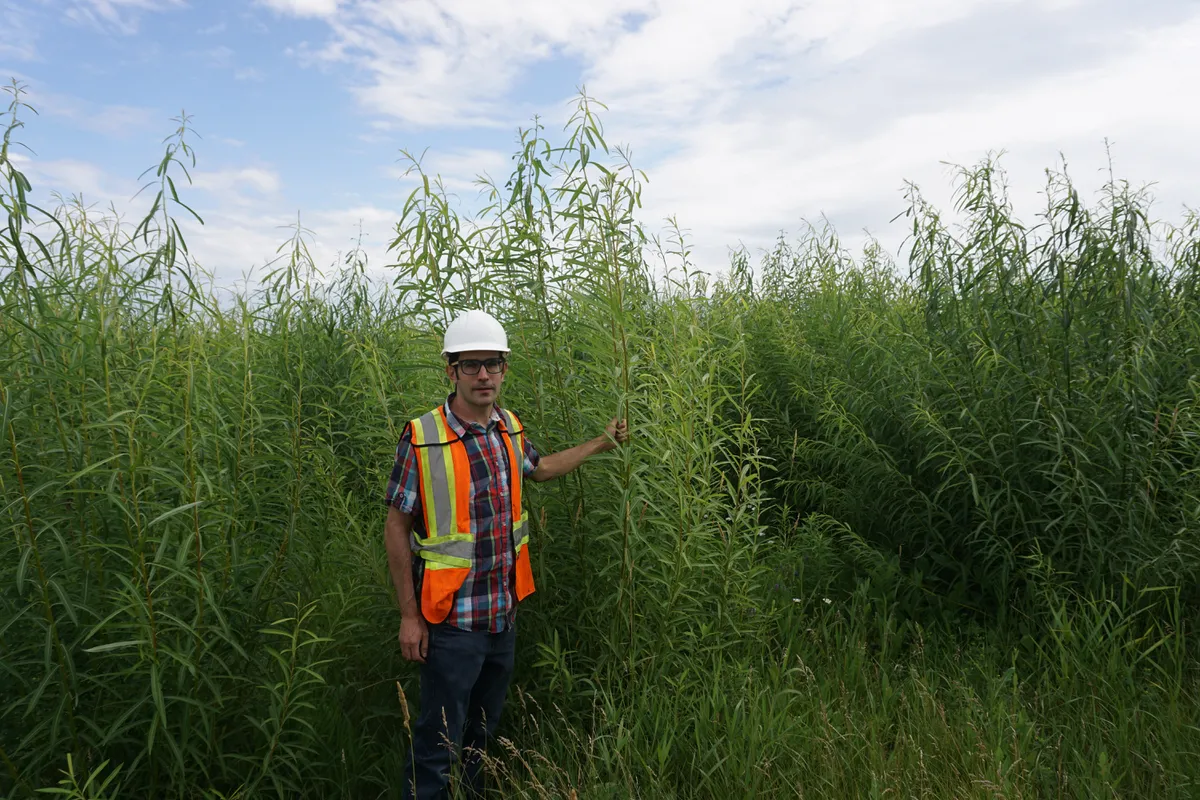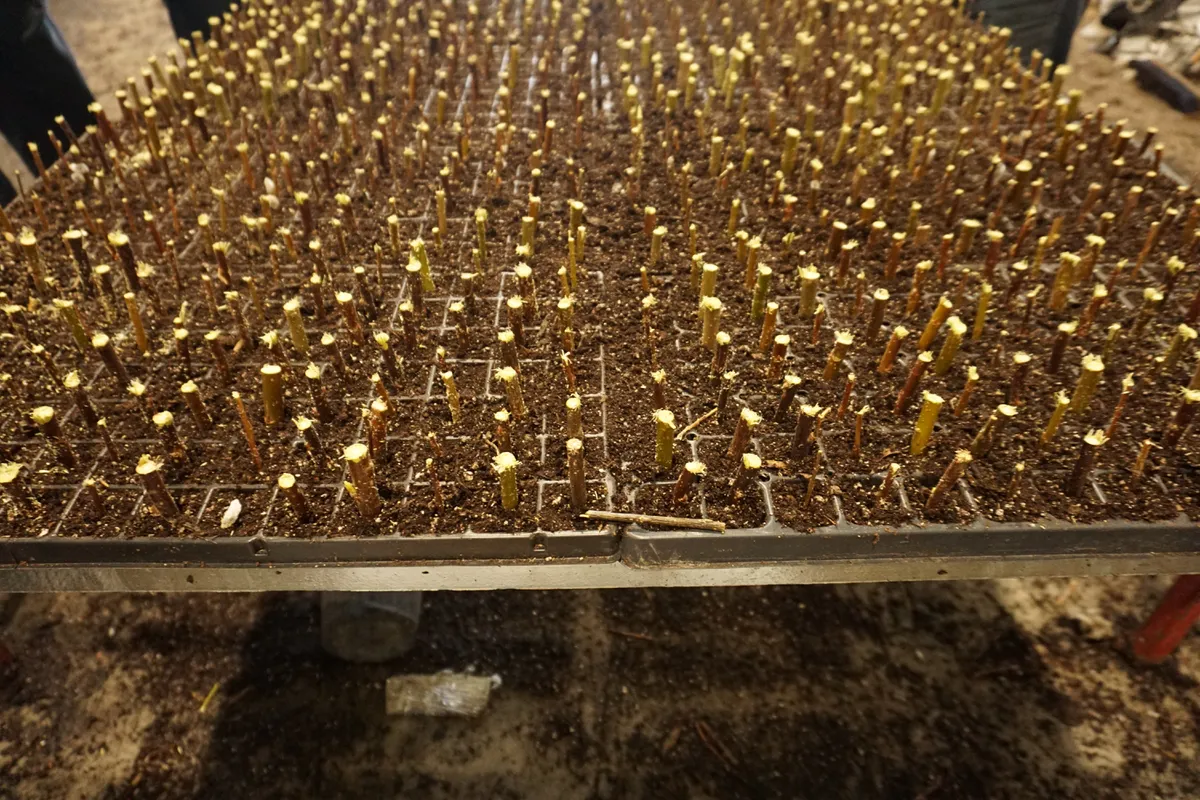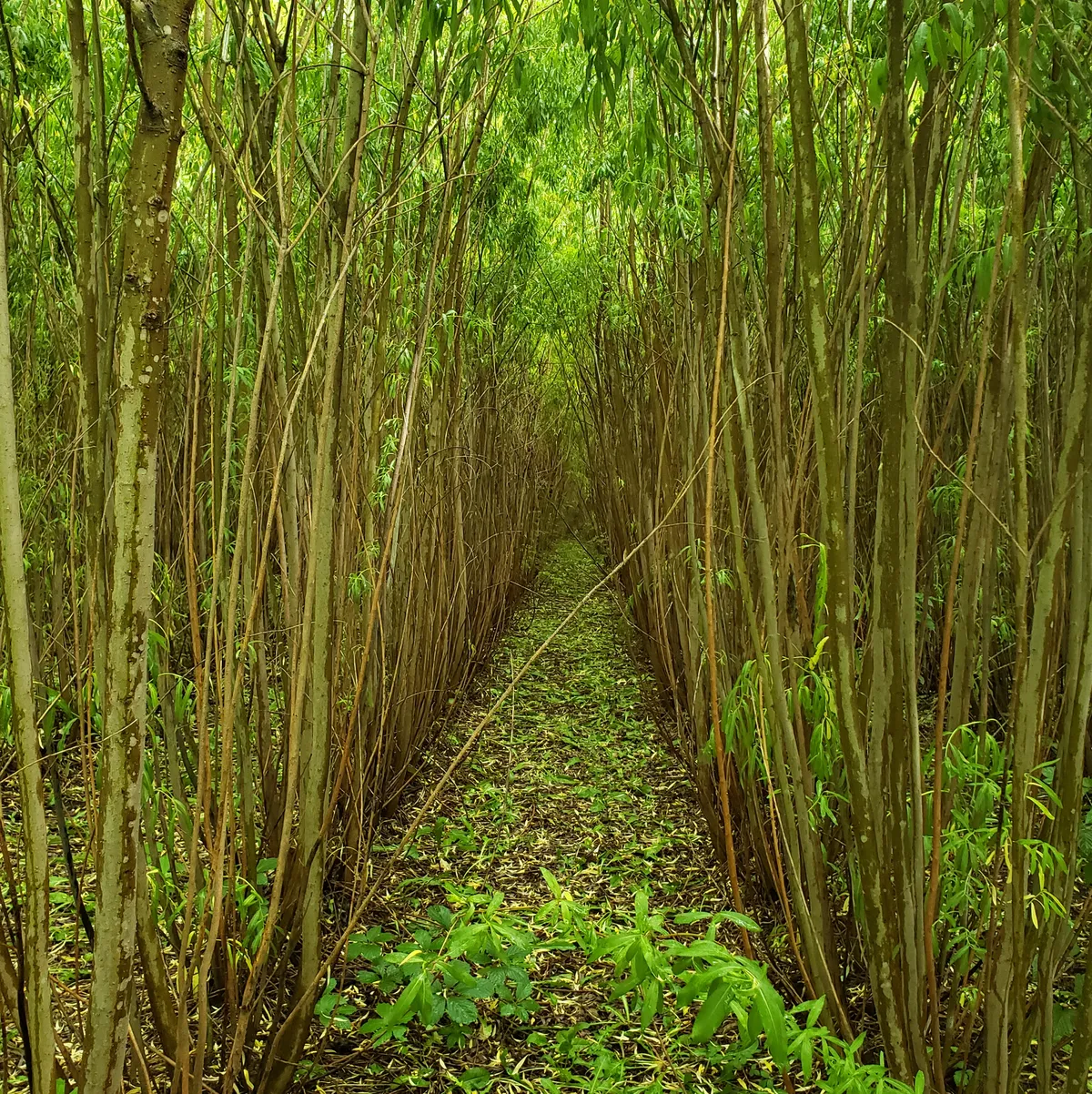
Francis Allard, President and co-founder, Ramo at the landfill in a willow stand in Quebec. MATTHEW MCCLEARN/THE GLOBE AND MAIL
Standing atop an old landfill, Francis Allard is in his element.
Mr. Allard is co-founder of Ramo, whose business is planting willows and poplars to help remediate landfills, mines and marginal land. At the Ste-Sophie Landfill north of Montreal, the company is growing willows to treat leachate from areas of the facility that were closed decades ago. Ramo harvests the trees every few years, weaving them into a variety of products, including fences and noise barriers. It’s also establishing a plantation in northern Quebec, to supply soil amendments for reclamation at nearby mines.
But Mr. Allard’s mood darkens back at Ramo’s new $7-million willow nursery nearby. Half of it was paid for using funding from the federal government’s 2 Billion Trees program (2BT for short). An early believer in the program, Mr. Allard scaled up Ramo’s capacity to meet the anticipated surge in demand.
He’s grateful for the support. But he’s nervously waiting for Ottawa’s response on planting projects for 2023 that Ramo proposed in February. The clock is ticking: To prepare plantations properly, he says, he’ll need to hear back by summer’s end at the latest.
“We had some funding to do some projects, but not at the level that we were expecting,” said Mr. Allard.
Though off to a slow start, 2BT is ambitious. Over a decade, the federal government aims to spend more than $3-billion to encourage provinces, territories, Indigenous groups, non-profits, landowners and others to establish new forests. These would cover 1.1 million hectares, an area twice the size of Prince Edward Island.
The government intends to lean heavily on those trees to help lower Canada’s greenhouse gas emissions, and estimates they will sequester 12 megatonnes per year by mid-century. One internal document obtained through the Access to Information Act stated that “there is no path to net-zero emissions that does not involve our forests.”
According to Natural Resources Canada, which administers 2BT, more than 500 million seedlings are planted annually. From 2026 to 2030, the program aims to plant another 300 million a year. An entire supply chain must accommodate that: seed collectors, tree nurseries and boots on the ground to plant them. Enough landowners must also agree to transform large swaths of land into permanent forest.
“We can expand our overall capacity,” said Rob Keen, chief executive of Forests Ontario, which has planted tens of millions of trees. “But what we need is that long term, sustainable funding to know that investments are going to have a return.”
Willows on a landfill: It’s probably not what most people envisioned when Prime Minister Justin Trudeau announced 2BT in 2019. Indeed, the program has taken heat for funding shrubs that in no way resemble pines or oaks. But such majestic trees take years to grow a few feet, while willows can grow that high in a few months. And they can be planted far more densely than most species, as many as 16,000 per hectare.
“We are probably the only type of project that is ready to go,” said Mr. Allard.
2BT has been roundly criticized for planting just 29 million trees in its first season. Victoria-based PRT Growing Services Ltd. is a large seedling provider: It can grow 330 million seedlings a year in North America. CEO Randy Fournier said many of his customers are eager to take advantage of 2BT. But currently, “it’s almost not even visible on the radar.”
By far the largest 2BT contribution announced to date – $32-million – went to Quebec’s forestry ministry. Spokesperson Sylvain Carrier said the money (the final amount is expected to be $26-million) went to planting seven million plants in public forests (mostly in areas scorched by wildfires) and another five million on private lands (most of it ravaged by insect infestations).
The City of Montreal was allocated over $5-million toward planting hundreds of thousands of trees to reduce its vulnerability to heat waves and manage the ravages of the emerald ash borer, which has killed tens of thousands of its ash trees. Meanwhile, the B.C. government received nearly $3-million.
Sources interviewed by The Globe and Mail were divided on how quickly Canada’s supply chain can respond. PRT’s Mr. Fournier said his company can’t deliver 100,000 spruce seedlings tomorrow, but it can grow mass quantities in as few as 12 months.
“As the rollout of 2BT picks up, there’s absolutely no reason that the supply chain of seedlings should show any ill effects,” he said. “The capacity is absolutely there.”
But not all planting applications can use saplings grown on such tight schedules. The opposite extreme are mature trees used in urban settings: Michael Rosen, a consultant and former president of Tree Canada, a non-profit that plans in urban areas, said urban forestry departments require specimens that are up to a dozen years old.
“It takes a long time to grow a tree to that size,” he said. “The program, I think he’s only got a 10-year life. So that’s a real conundrum.”
Daimen Hardie, executive director of Community Forests International, said 2BT would represent a major change for seed collectors, too. If the program wants to plant resilient forests, it will demand a wider variety of species than forestry companies use in their replantings, he said.
Hoping to stimulate investments throughout the supply chain, this year NRCan began accepting multiyear funding proposals. Anne-Hélène Mathey, an executive director at NRCan in charge of 2BT, said nearly all successful applicants had proposed multiyear projects, and nearly all of them have been notified. (They haven’t been announced publicly yet, however, as formal agreements haven’t been signed.)
“The feedback is that this is a sound approach, from both nurseries and recipients,” she said.
The trickiest thing could be to find enough land. Canada is the world’s second-largest country, but tree planting competes with other uses, such as agriculture and future municipal development.
2BT’s most obvious targets are previously forested areas severely damaged by wildfire or insect infestation. But Ottawa also wants to expand forests within cities. Mr. Rosen said many old neighbourhoods may be reaching maximum canopy, but newer neighbourhoods and industrial parks have space available.
Community Forests International has restored more than 1,200 hectares of forest in the Maritimes, which are held in trust to ensure they remain forested in perpetuity.
“I think land availability definitely is going to be a problem,” said Mr. Hardie. “It’s already a challenge for us.”
NRCan’s Ms. Mathey said NRCan chose not to demand formal guarantees from participants to preserve the new forests, because it believed legal covenants would severely limit the program’s appeal. The volume of applications received to date indicate there’s sufficient public, agricultural and urban land available to support 2BT’s growth, she added.
“So far, I would say we don’t have any cause for concern,” she said.
Tree planting is rapidly becoming a popular nature-based solution to address climate change. In 2018, New Zealand’s government announced plans to plant one billion trees by 2028. Australia followed suit the following year, aiming to plant one billion trees by 2030. Also in 2019, the United States introduced the Climate Stewardship Act, which included plans to plant 4.1 billion trees by 2030. Ireland promised to expand forests to nearly one-fifth of the country by mid-century.
In this big numbers game, several realities are worth keeping in mind. Years ago, the Intergovernmental Panel on Climate Change suggested one billion hectares of additional forest would be needed to limit global warming to 1.5 C by 2050. 2BT’s contribution, if realized, would represent one-tenth of 1 per cent of that.
And while two PEIs is nothing to sniff at, according to the national forest inventory, Canada’s forests sprawl over nearly 3.5 million square kilometres. By one estimate, those forests contain 318 billion trees. So, if Ottawa plants two billion more, it will have added a mere 0.6 per cent to that total.

Trays of willow cuttings inside the new Ramo willow nursery building in Quebec. MATTHEW MCCLEARN/THE GLOBE AND MAIL
As those trees get established, more could be harvested or burned. According to the World Resources Institute, a global research organization, Canada lost 2.5 million hectares of forest last year alone. “The rate of loss is significantly higher than the rate of gain would occurred directly through this program,” said Will Anderson, WRI’s manager of restoration projects.
Boreal forests grow slowly, so there’s a real risk that 2BT’s trees won’t stand long enough to deliver benefits. Other plants that compete with them for light might need to be removed. During droughts, saplings might even require individual watering to survive. Future owners might cut the trees down.
All that points to a need for monitoring and verification. Establishing initial site conditions, tracking survival rates and measuring carbon sequestration consistently all require careful thought. But this is where many international tree planting efforts have fallen down.
“The common thread that we see, even today, with all of the countries we work with, is that they haven’t budgeted or planned for monitoring,” said Dow Martin, who manages mapping and monitoring of landscape restoration at the World Resources Institute.
Ms. Mathey said 2BT has set aside funding for monitoring sites after the program winds down. “There are all sorts of technologies and techniques that exist these days, from remote sensing imagery to LiDAR, to ensure – without deploying 3,000 public servants – that we can monitor the fate of these trees.”
MATTHEW MCCLEARN
The Globe and Mail, August 7, 2022


